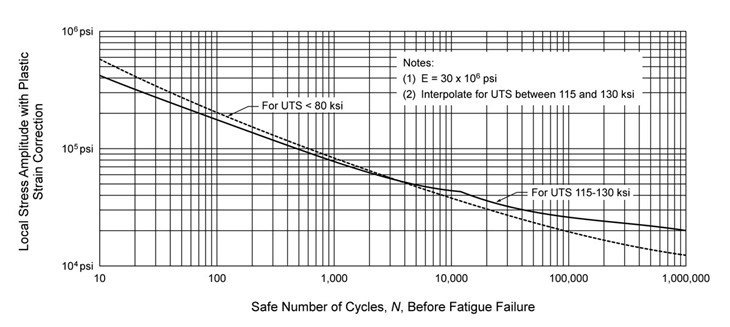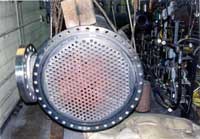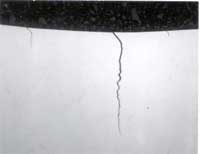The predictive power of finite element mathematical simulations can often prevent the loss of millions of dollars in downtime, industrial catastrophes, injuries, and loss of life.
Cyclical stress factors
In materials science, fatigue refers to failure that results from cyclical stress. Most often, such failures manifest themselves in some form of mechanical or thermal fatigue, often as a result of vibration, loading and unloading, or repetitive fluctuations in temperature. These failures are often blamed on the designer or fabricator, when the real cause is transient operating conditions. For instance, operators often increase applied loads and temperatures in an effort to increase productivity; as a result, they inadvertently push the limits of fatigue damage and increase the risk of failures.
As a point of reference, it is estimated that fatigue contributes to approximately 90% of all mechanical service failures (1). An increasing demand for high performance industrial systems has exacerbated the likelihood of structural fatigue.

Fatigue as the cause of weld failures
Weld failures present one of the most serious financial, safety, and reputational threats across many sectors including: chemical, petrochemical, aerospace, automotive, construction, and energy. Any component that exceeds its fatigue or endurance level can trigger a weld failure. They can occur suddenly, causing catastrophic failures that could have been prevented by prior analysis and repair.
The nuclear industry was the impetus to develop fitness-for-service (FFS) practices. In particular, the ability to quantify the tolerance of weld defects played a key role in validating the safety of nuclear vessels.
Still today, however, few industries outside of chemical and nuclear are well- versed on the availability and exactness of FFS procedures. As a result, many companies fail to verify fatigue tolerance and safety margins before making the costly decision to replace components that are evidencing surface damage.
By employing FFS measures, many companies could have the capacity to design and safely implement repairs to restore fatigue and fracture-safety margins, even given an operational environment of cyclical stresses. Making an informed decision to repair or replace the compromised component requires a multi-faceted investigation that yields quantifiable results.
Companies often opt for metallurgical analyses to evaluate and act in response to weld cracks. Metallurgical analyses are limited, however, and unlikely to address fatigue or fracture analyses. Without quantifying a component’s integrity, decision makers are left to select a path of action based on an incomplete picture. Only in the presence of reliable data can the decision to extend fatigue life be made with confidence.
The predictive power of mathematical simulations and fatigue evaluations
Modern materials science and mathematical simulations provide the most robust method of evaluating FFS. Finite element analysis is a scientific process that integrates engineering principles and mathematical physics. As the name implies, finite element analysis divides the entirety of a complex structure into multiple and precise elements. This exercise identifies what occurs under various conditions of cyclical stress and allows for accurate predictions about future cracking. Increased operating loads and the reduction in brittle and ductile fracture margins that arise from higher applied static and dynamic loads. Simulations are also useful in quantifying the reduction in fatigue life due to an increased number of operating cycles, as well as the relationship between failure causation and aggressive operating conditions. Also of importance, mathematical finite element simulations can con rm whether stress limits meet industry Codes and Standards.
When is fitness-for-service the right choice?
Two circumstances often prevent companies from engaging an expert to conduct an FFS evaluation. First, many companies are unaware of the value of nite element analyses and mathematical simulations in identifying and resolving fatigue-related failures. Secondly, because fatigue failures can occur as a result of unexpected cyclical stresses rather than an anticipated source of stress, the existence of fatigue damage is often overlooked.
Specific to weld failures, FFS evaluations can demonstrate the structural integrity of tanks, vessels, and other process equipment. The acquired data empirically supports the decision to run, repair, or replace the component in question. At times, companies assume that weld repairs are not an option, so they replace damaged components. In many cases, however, repairs are feasible. The critical decision to repair or replace an in-service component can be guided by finite element mathematical analysis.
In general, FFS investigations are well-suited when companies need to quantify and predict continued service: the residual life of an in-service component; safe operation beyond the original design life; tolerance to defects; and the impact of an outage or shutdown.
Capturing the value of FFS
Most companies are stretched to the limit to increase production, decrease costs, and ensure safety. Unfortunately, fatigue failures are all too common, and they work in direct opposition to a company’s objectives.
Decision makers can more confidently mitigate the risk and expense of failures when they can reliably assess their options. FFS evaluations can quantify and demonstrate the ability to extend service life and avoid the costly process of replacement. FFS evaluations often reduce maintenance and operating costs as well, which is one more benefit companies can glean in today’s competitive marketplace.
About the author
About the author
Dr. William J. O’Donnell is founder of O’Donnell Consulting Engineers, Inc. a firm that provides failure causation evaluations in state, federal, and international courts. In addition to materials testing for metallurgical failure analyses, the firm uses finite element computer simulations and materials to quantify engineering failure causations.
Dr. O’Donnell is active in Codes and Standards in the areas of fatigue and fractures, and he has published more than 100 technical papers related to stress analysis methods, elevated temperature design, and corrosion fatigue life. He can be reached at +1-412-835-5007 or by email at wjo@odonnellconsulting.com. More information is available at www.odonnellconsulting.com.
Reference
1.http://www.asminternational.org/documents/10192/1849770/05224G_Chapter14.pdf
The prevalence of joint weld failures
Perhaps the most prevalent and underestimated weld failure is the common soldered joint. Few companies give enough attention to the dangers that exist in their plants, storage tanks, equipment, or heating and plumbing systems as a result of soldered joints.
Unseen risk
The bene t of a soldered alloy is that it can be melted sufficiently to join together two other pieces of metal. Unfortunately, it is this same melting property that makes a soldered joint so likely to fail.
The average melting temperature of solder is a relatively low 350o Fahrenheit. What might otherwise be a non-threatening equipment malfunction or overheated system can become fatal if the temperature rises above this level.
Unexpected fatalities
Case in point: when a teacher noticed steam escaping from a faucet in one of the school’s restrooms, she went to the boiler room to investigate. She was in the wrong place at the wrong time. The increased temperature of the heating system had caused the soldering on both ends of an elbow to melt. Because the system was pressurized, the soldered piece did more than loosen; it shot like a missile, striking and immediately killing the teacher.
Call to action
It is an all too common practice that companies live in reaction mode, identifying and resolving weld failures as they occur. The very real threat posed by soldered joints often goes unnoticed.
To avoid interruption of operations and the potential loss of life, heater systems should be inspected for faulty temperature controls on an annual basis.

The increased temperature of a heating system caused the soldering on both ends of this elbow to melt, resulting in the death of a high school teacher.



